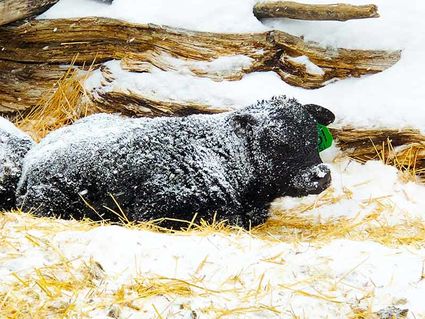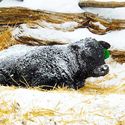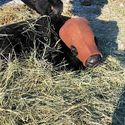Harsh winter hard on everyone, including Livestock
March 7, 2018

The winter has bee the fifth coldest on record according the National Weather Service. Its's been hard on anything living and that only makes calving season a bit more complicated.
The winter of 2017-18 will be talked about for many years to come just as the winter of 1978-79 is still fresh in the minds of those there to experience it.
That winter was extremely cold and provided many problems that some couldn't overcome. There were lambing and cow/calf operations that had to sell off their entire herds because they couldn't maintain them. The city of Chinook had experienced more than 55 water main breaks at local residences and as many as five main line breaks by February first.
By the middle of the month the City of Chinook was being notified of an average of 5-6 water line breaks a day leading to an order for all households to maintain a pencil size flow from all spigots in the residence.
Many of the records established that winter have been exceeded this year including snowfall recorded in January and February.
The average snowfall for the region in February is 5.8", this year we had 31.8" breaking the record set in 1978. For the season the record set in 1977-78 for total snowfall was 68.5", in 2018 we have recorded 78.3".
In addition this winter ranks as the fifth coldest on record. The average daily temperature in February was 1.5˚, normal is 22.2˚ a departure of - 20.7˚. The coldest on record is the winter of 1936 with an average daily temperature of -12.8˚.
With the elements being so brutal everyone in the region has had to deal with plenty of hardships. Blaine County has suffered two deaths related to the weather and many residents have had to rely on the generosity of neighbors to make it through.

Blaine County is first and foremost an agricultural community and with many ranchers having already started, completed or in the process of preparing for calving season.
The calves are coming, regardless of the weather and its up to the ranchers to ensure the calves can survive such harsh elements.
Some operations have indoor facilities to help ease the process during the winter but many have to deal with conditions in a much more hands on approach.
Jeff and Christie Nissen operate a 250+ head, Commercial Cow/Calf operation between Chinook and Harlem, Montana. The couple were married in 2009 and have two children, Charley Anne and Tyson Larry. The hay side of the operation is ran on the family farm by Jeff's brother Mike and their Uncle Jim.
The Nissen's calve in the fall, beginning the middle of August and in the winter beginning the end of January.
This winter, calving has forced the operation to deal with the extreme cold and abundance of snow head on.
Just getting the cows fed has become quit a chore, "The additional plowing needed, just to be able to get to cows fed is incredible. The cattle can't get around in the deep snow, so we've had to plow paths for them and clear out areas for them to be in. Jeff's brother, Mike, helps us out with feeding in the winter and he has plowed a ton of snow these past two months," said Christie.
The wind of course doesn't help, "We could plow a road one morning, get cows fed and sometimes even within a few hours the road would be drifted in. We've had to plow into the haystacks just to be able to get to the hay," she added.
The calves are coming regardless so more supplies are being used, "We had quite a few calves born before and throughout the cold, we made sure to bed with straw generously to try and keep the calves protected from the elements. As a result, we have used a lot of our hay and straw that was in our reserves.
The Nissen's don't have an indoor facility big enough to accommodate the cows, "The barn is set up with individual pens for cow-calf pairs after they have calved. There is one large corner pen with just enough room for one cow to calve and also an open area at one end that will work as a labor pen for one cow," said Christie.
With the brutal cold, checking cows ready to calve happens way more often, "In typical weather we usually check the cows at night about every 3 to 4 hours, in cold temperatures, we are checking cows about every one and a half hours. The time frame varies as well depending on how many heifers are calving as opposed to cows," stated Christie.
Frostbite can affect anything living exposed to the elements , "We have really struggled this year with frozen ears on calves. We have masks or "Tukes" that we use on the first born and younger calves to try to protect their ears from the elements. The Tukes cover their heads, folding their ears back towards their neck to keep them tucked in and warm.
Being a registered breeder means added requirements, "We collect more data and keep more records than a typical commercial cow-calf operator. We take a birth weight within 24 hours of a calf being born. Within the first week of being born, we vaccinate the calves with their first series of shots and tag them. Their tags include the dam's tattoo number, the sire's name abbreviation or tattoo and the tattoo used for the calf's id. When the weather is below zero, we don't tag any of the calves. The small hole made in the calf's ear when inserting the tags makes their ears more susceptible to freezing. This year we have had very few days where we've been able to tag calves," Christie explained.
The cold certainly has an affect on the cows as they prepare to calve but does it alter the calves birthrate, "We started calving our registered cows the middle of January, shortly after the first cold spell of the year and we are getting close to the end with them. The first 2/3 of our calf crop was born by mid February, so those cows were exposed to a shorter time frame of cold weather increased feed consumption. We didn't notice any significant increases in birth weights for calves born during that time. As the calving season continues, we anticipate that some of the later birth weights may be higher due to the additional feed consumption and lack of exercise during the cold weather," said Christie.
Monitoring the calves health in the days following their birth is certainly a priority, "With all the snow and cold, you have to watch the calves closely for sickness and to make sure they are staying warm and not getting chilled. We have put a lot of straw out this winter to give them some protection and a warm bed."

A newly born calf at Nissen Angus has his/her ears immediately covered with a 'Tuke' to protect its ears from the elements. The winter of 2017-18 will be remembered for years and currently is the fifth coldest on record while also receiving a record amount of snowfall.
While this winter has had its challenges Christie reminds us that things could be worse, "It's important to emphasis that even though this winter has had its many challenges, it could always be worse. Some places in the mountains and over west have been hit really hard with snow – more than we've had to deal with here. The last few winters have been unseasonably warm and we got accustomed to "having it easy." We needed some snow cover for some much needed moisture this winter and we are crossing our fingers it warms up slowly and soaks in instead of flooding.




